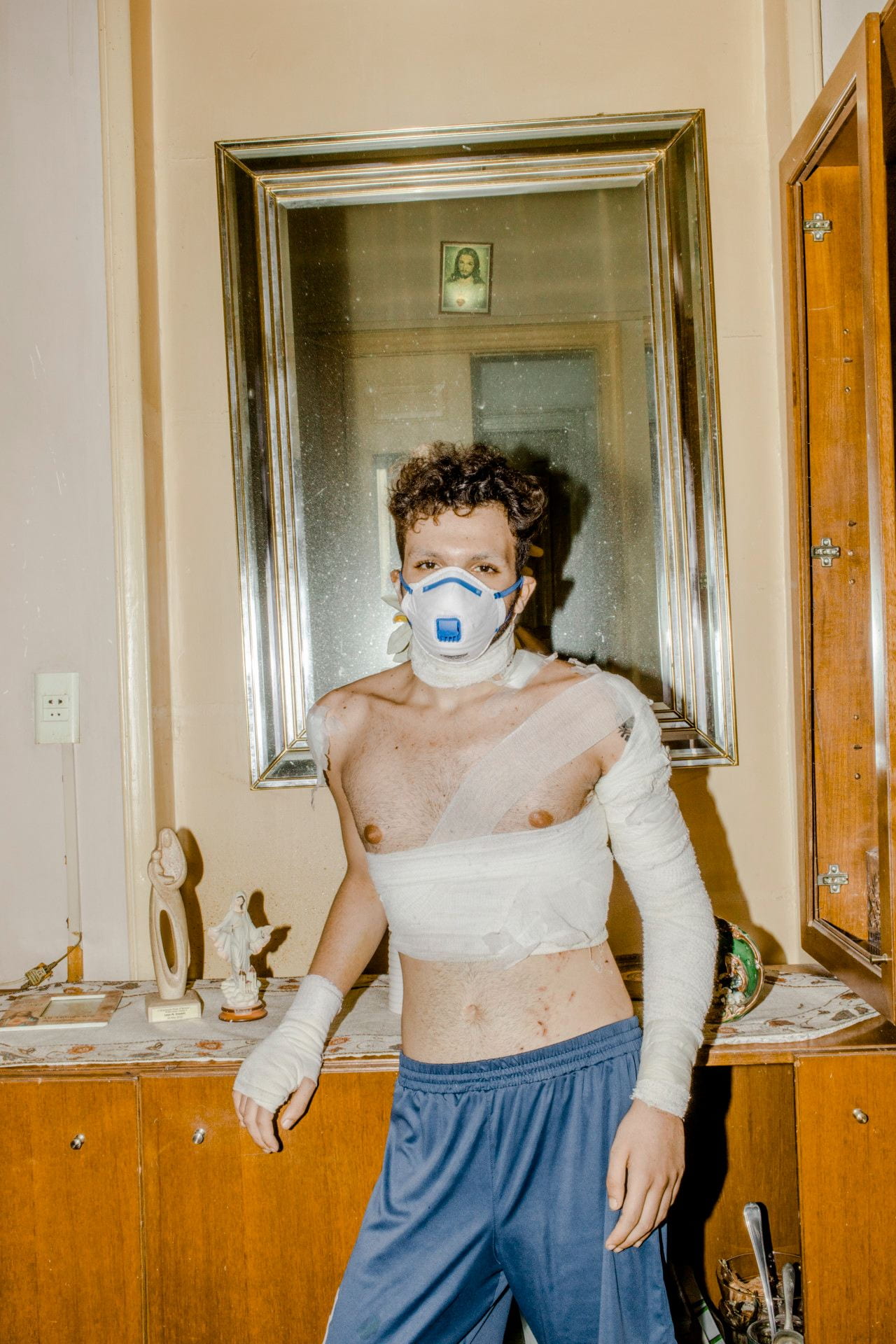Google Slide Presentation:
https://docs.google.com/presentation/d/1W0sEQC4SCYSO234MeDbtDwVtITrvLxZaCQhtDt8xJOI/edit#slide=id.p
Main Image:

Myriam Boulos, Untitled, August 2020, Portrait of Andréa Najarian
Presentation notes:
- This is a portrait of a person. They are standing in the foreground and have bandages wrapped around them. They are wearing a face mask and are propped against a cabinet that has a missing door. We can see another cabinet on the right with a missing frame that is usually made of glass. In the background, we see a tilted and dusty mirror reflecting on an icon of Jesus Christ.
- This person is called Andréa Najarian and their portrait was taken following the August 4th Beirut port explosion by the brilliant Myriam Boulos who is a Lebanese photographer.
- Andréa is a Lebanese drag queen and makeup artist based in Beirut, whose house has been greatly affected by the blast, as well as their mental and physical health.
- I remember seeing this picture following the blast and finding it very striking, perhaps because I knew who Andréa was before stumbling upon it.
- This is how I was used to see her and how she presents herself on her personal social media. Of course, only a minority of Lebanese people would have known of her. Mainly people from the younger generation of Beirut’s creative and queer environment.
- In times of crisis, Andréa showed great courage in exposing themselves in such a manner. Being out of drag and showcasing his scars front row and center cannot be an easy task, especially such a short period after the disaster. But he knew that the picture was going to make a lot of noise, not only on a regional level, but on an international level.
- Thanks to his portrait, amongst others, Myriam Boulos, the photographer, joined Magnum as a nominee in 2021. She gained a lot of international exposure , did two photoseries for the Times magazine and even secured her place in the Times’s “Top 100 Photos of 2022”
- We are beginning to sense a pattern of young creatives being at the center of disasters and documenting them as they go. These creatives showcase the aspects of Lebanon that nobody talks about — perhaps the strongest being the queer scene of Beirut. It is no news that marginalized communities suffer even more during periods of crisis, but the LGBTQ+ community in Lebanon and in the expat community showed great support and resilience after the blast.
- Another interesting photographer who worked with Andréa is Mohamad Abdouni. He illustrated Lina Mounzer’s essay entitled ”What We Lost That Day” that was published in the NY Times.
- Mohamad Abdouni is an openly homosexual Lebanese photographer, filmmaker, and visual artist. He is well known for showcasing the Lebanese queer culture, especially in the photo journal he published “Treat Me Like Your Mother” or in the magazines “Cold Cuts”. The second issue of the latter coincidentally chronicles the lives of Doris and her genderqueer son Andrea. Together they challenge the social norms of a patriarchal society and the so-called family values of a Middle Eastern family.
- As we go back to the initial picture I have showed you, I hope you learned a little bit more about Andréa and what they represent to the Lebanese queer community. Even though this picture is at first glance extremely sad, I believe that it represents a real beam of hope in the Lebanese society as a whole. Even though it sometimes seems like the government and citizens want to silence the LGBTQ+ voices, they are the ones that show up in times of crisis. They are the ones who were on the streets protesting, documenting, speaking up, and they are the reason why a lot of people know about what is going on. You may not notice it but where there is activism there is queerness in Lebanon and I can attest to that. The community is relentless and does not back down in front of obvious challenges such as the religious stigma that comes with facing topics of homosexuality. I think the religious icon is an important part in Andréa’s portrait really echoing the fact that despite being shamed and rejected a certain demographic, the christian Lebanese one in that example, the LGBTQ+ community shows endless compassion, patience and tolerance when faced with daily ignorance.
- So in this quick presentation, I hope to have showed you a side of Lebanon that you might not be familiar with, but that is very well present and alive, that takes up a big part of the visual culture of the Beirut youth, and that is at the root of every positive change that is happening in my country.
